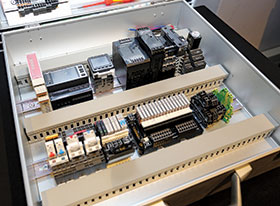

A smaller, standard component height across all of Omron’s family of factory automation (FA) control devices allows for standardised wiring ducts and component placement, thereby optimising space.
The complete Omron portfolio has been redesigned into 600 different FA devices, across 18 different product categories, all built to a common design platform. In addition, the new FA devices are also built with Omron’s proprietary Push-In Plus wiring technology.
Moving to a uniform design avoids the dead space that results from specifying components of differing height, and also reduces the design work required. Most importantly, the ‘hot spots’ that build up in small spaces in the panel are greatly reduced, which can impact component reliability.
“The lifetime of an electronic component, like a power supply containing an electrolytic capacitor, may be halved for every 10°C rise in temperature, as in accordance with Arrhenius’ Law,” explains Lars de Bruin, marketing manager, Panel Solutions, EMEA.
Omron’s complete new range of compact in-panel components includes electromechanical and solid state relays, I/O relay terminals, terminal blocks, temperature controllers, timers, measuring and monitoring relays, power monitors and (uninterruptible) power supplies. These products also offer features such as LED status indicators, simple front wiring and Push-In Plus terminals, all helping panel designers to optimise panel layouts, without impacting issues such as usability or maintenance.
Double DIN-rail fixation, both at the top and bottom, allows customers to remove the product from the DIN-rail in a straight move, which is highly convenient in case of replacement/ refurbishment.
Downsizing components
The range encompasses slim in-panel component designs that offer widths of as little as 6,2 mm, as well as on-panel components with reduced depth. The dead space in a panel can be reduced by as much as 50% horizontally, 20% vertically, and 30% by volume, compared to older models.
Due to reduced power consumption, and therefore generating less heat, side by side mounting is possible at ambient temperatures up to 55°C, which leaves additional space in the panel.
Switch mode power supplies
The S8VK-S switch mode power supply has a compact body with 36% less volume than previous Omron products, and allows side by side mounting, in close contact, to reduce the footprint which, in turn, helps to downsize control panels. It also meets a broad scope of certification standards, and ensures stable operation in a range of environments, with greater environmental resistance and a wide operating temperature range of -40°C to 70°C.
Power monitors
The KM-N2 power monitor series offers all functions required for in-panel installation. The use of general purpose current transformers (CTs) enables it to be used at a variety of manufacturing sites. The series includes single and three-phase four-wire power monitors. It is compatible with power supplies around the world, while providing measurements of up to four circuits in one unit. This power monitor also features precise measurements (IEC Class 0.5S), incorrect wiring detection, and large, easy-to-read, white LCD characters.
Timers
The H3DT slim timer series is designed to be mounted within control panels. It comes with a slim 17,5 mm wide body, which has two relay outputs, helping to downsize control panels. Power consumption is up to 60% lower than that of previous Omron timers, reducing the DC power supply load for an entire control panel.
Relays
The K8DT is believed to be the industry’s first measuring and monitoring relay series with transistor outputs. The series includes nine models, including current monitoring, voltage monitoring, phase sequence and phase loss relays (to prevent reverse operation) and temperature monitoring relays.
Solid-state relays
The G3PJ solid-state relay (SSR) series for single-phase heaters has a slim body, with a 22,5 mm width for DIN-rail mounting. It is about 50% slimmer than previous Omron relays. This low heat-generating SSR can carry a 25 A current, even with close-contact mounting of three SSRs, helping to save more space and downsize control panels.
Temperature controllers
The new E5xxC-B series with Push-In Plus terminals helps reduce the time and work involved in wiring by inserting wires simply without having to use tools.
DIN-rail terminal blocks
The XW5T/XW5G DIN-rail terminal blocks use Push-In Plus technology and the minimum width of 3,5 mm saves wiring work and installation space.
For more information contact Omron Electronics, +27 (0)11 579 2600, info.sa@eu.omron.com, www.industrial.omron.co.za
| Tel: | +27 11 579 2600 |
| Email: | info_sa@omron.com |
| www: | www.industrial.omron.co.za |
| Articles: | More information and articles about Omron Electronics |
© Technews Publishing (Pty) Ltd | All Rights Reserved